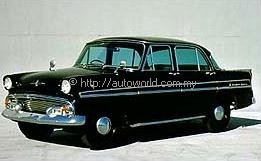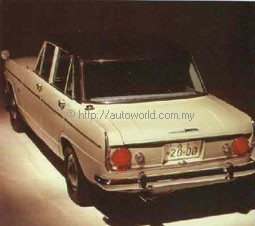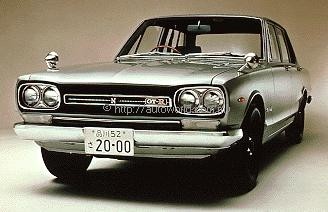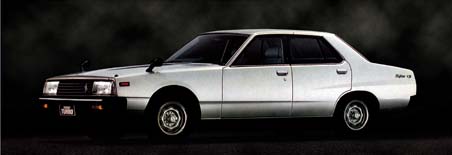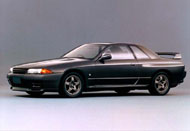History of the Nissan Skyline
The Skyline is a respected model in Japan because it has quite a long history. The first generation was built in 1955 by the Prince Motor Company. At that time, Prince Motor was an independent automaker, having evolved from the Tama Electric Car Company which had been formed by the Tachikawa Aircraft Company.
Prince Motor was merged with Nissan in 1966 when the Japanese government urged the larger car manufacturers to take on the smaller ones in order to make the motor industry stronger and more competitive. However, given the fame of Prince Motor and its Skyline, the company still has a ‘presence’ as there is a Prince division within Nissan which is responsible for the development of Skyline models.
The very first Skyline was the ALSI introduced in 1957. It had a 1.5-litre OHV 4-cylinder engine which produced 60 bhp. Sedan and stationwagon bodystyles were available. There were actually three variants of this first generation which was in production till 1963. A second variant had a more powerful 70 bhp engine.
There was also a sporty 2-door coupe and convertible which had been styled by Michelotti of Italy. This can be regarded as the ancestor of today’s Skyline coupe and it certainly had performance to match its sporty looks – a 1862 cc OHC engine which developed 94 bhp. However, it was rather expensive in those days and not many were made.
The Skyline’s high-performance roots can be traced by to 1964 when Prince Motor went racing with the second generation. For the purpose, the 2nd generation S50 model’s wheelbase was extended by cutting the car off in front of the firewall and adding an extra 200 mm to enable 6-cylinder engine fit in. The use of a 6-cylinder engine would become a dominant powertrain feature of the Skyline. The engine used was the G7, a 1988cc SOHC unit from the S40 Gloria model.
The company made a limited number of cars to gain homologation for Japan GT racing. When enthusiasts started to buy up all the units, the company saw it had a winner and started making more, giving birth to the Skyline 2000GT which came in GT-A and GT-B versions.
The GT-A used an unmodified G7 engine with only a single carburettor and produced 105 bhp. The GT-B had a 5-speed close-ratio gearbox, full instrumentation, LSD, powerful servo brakes, a 99-litre fuel tank and a high compression version of the G7 with three carburettors, and it produced 125 bhp. The GT-B was the obvious choice for racing and finished 2nd in its first race, the 2nd GP of Japan in 1964 – it almost beat the victorious Porsche 904GTS, which was a pure racing car. This was an incredible achievement considering that the Skyline was a 4-door sedan.
Of course, the basic sedan was still offered and as time went on, it was improved in many areas. It was this generation that introduced the characteristic four round tail lights that would be a styling feature of Skylines for many generations. In 1967, the S57 series was launched with a brand new 1483cc SOHC 4-cylinder which produced 88 bhp, then the most powerful 1500 cc engine in Japan.
By the time, the third generation appeared in 1968, the Skyline was a highly respected sports sedan and the GT-B was a hot favourite. Enthusiasts eagerly waited to see what a new GT-B would be like and in early 1969 came the very first Skyline GT-R (PGC-10).
The Skyline 2000GT-R was powered by the S20 engine, a 1998 cc DOHC inline-six which produced 160 bhp – as much as a Porsche 911 of that era. It was initially a 4-door sedan but in 1971, a coupe GT-R made its debut and this had a shorter wheelbase and was lighter. The racing Skylines clocked a total of 83 victories in a short period before production was stopped in 1972 (possible because of the fuel crisis period as well as stricter emission control standards). With only 197 units produced, this was the last car to have the GT-R badge for more than a decade.
The 5th Skyline generation will be remembered by older Malaysians as it was assembled here in 1980 as the 180K. Though fuel-efficiency was emphasised, there were still ‘hot’ Skylines and one version had a 140 bhp turbocharged engine, the first Skyline to use the device to boost power.
In the mid-1980s, a new engine family, the RB20, was used in the Skyline. Nissan engineers started to put in high-tech features such as HICAS (High Capacity Active Steering), an all-wheel-steering system which improved the handling of the car immensely.
Over a decade after the last GT-R had been made, an all-new Skyline GT-R arrived in 1989, much to the delight of enthusiasts in Japan (the model was not officially exported anywhere). This made a strong impression and was packed with high-tech features. It came with ATTESA-ETS (Advanced Total Traction Engineering System for All – Electronic Torque Split), an electronically controlled all-wheel-drive as well as Super-HICAS.
The new GT-R won lots of praise for its balanced handling as well as sheer power which got it from standstill to 92 km/h in 4.8 seconds. It had the RB26DETT, a 2.6-litre DOHC inline-six twin turbo which generated 280 bhp. This engine was really a racing powerplant, derived directly from Group A racing. A typical HKS-modified Skyline would do 950 bhp and spin to 10,000 rpm and there are rumours that some tuners have pushed the output to as high as 1,300 bhp!
The GT-R was basically a racing car you could drive on the streets and before long, it earned the nickname of ‘Godzilla’. It was a car that could be taken from showroom to the racetrack and still perform respectably with a skilled driver behind the wheel. So successful was this car that Group A racing was abolished in Japan because no one could challenge the Nissan! Enthusiasts overseas lusted for this car but Nissan only exported it to a few markets.
As a model in the Nissan range, the Skyline has also been a popular mid-sized sedan and last year saw the 11th generation being launched. This generation sees two significant changes: one is that the hardy and powerful inline-six engines have been replaced by all-aluminium V6 engines and the Skyline is also moving a bit higher in terms of image to the luxury class.




